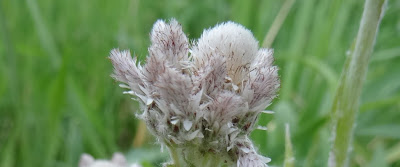6/28/2022
On 5/20/2022 we peeked into the nest box, and found several eggs. Not countable, because of the feathers in the box meant to hide the eggs from predators. Since then I have peeked several times more.
The female adult was incubating the eggs. I noticed the adults going in and out of the box on June 3 since the eggs had hatched and they were bringing food to the hatchlings. After two weeks in the box the nestlings had grown enough so they were full size and had gained some flight feathers. On June 21 most young fledged out of the box, ready to learn how to fly and hunt for their own food: flying insects.
On June 22 the adults coaxed the last young bird to fly. A few days later, we saw 3 of them perching on a branch looking over the pond.
6/19/2022
6/17/2022
6/12/2022
smooth penstemon
Foxglove Beardtongue, Penstemon digitalis (also called Smooth Penstemon) has white flowers that bloom for a month or longer.
The tubular flowers attract long-tongued bees such as bumblebees and mason bees, as well as hummingbirds. This is one of the plants we are trying to encourage in the riparian area around the pond.
Good for pollinators!
6/11/2022
iris
Northern Blue Flag
Iris versicolor, is blooming
again near the pond.
This year each plant seems stronger and more colorful with the background of grass green.
These grow near the green/white striped leaves of Sweet Flag (Acorus).
6/08/2022
blackbird nest
The Red-winged Blackbird Agelaius phoeniceus gave away the secret location of their nest by screeching at us as we walked around the pond. As I came near the spot, he warned me vocally and hit my hat with his feet as he flew by.
6/06/2022
sora chicks
Described as "secretive" birds and rarely seen, we have a pair of Sora Porzana carolina living in the wetland around the pond. I saw a lone egg a few days ago, and thought it was the start of a clutch. Today, this little black cotton-ball with orange/red tufts under his big beak appeared! Soras start incubating eggs when they have only a few in the nest, and go on laying eggs (one a day) until they have around a dozen eggs. Consequently, each chick hatches on different day. One parent tends to the hatchlings and the other continues incubating the remaining eggs until each hatches.
6/05/2022
6/03/2022
6/01/2022
pussytoes 6-1
Pussytoes Antennaria neglecta spreads as a groundcover, with basal leaves surviving through winter close to the ground.
In springtime, flowers emerge on tall stalks and look like toes on kittens.
The lower surface of each basal leaf is silvery white with dense matted hairs; the upper surface is gray-green and woolly. In summer, the old basal leaves shrivel up and disintegrate, leaving the short plant and root to hide in the surrounding vegetation until next Spring.
Subscribe to:
Comments (Atom)

















